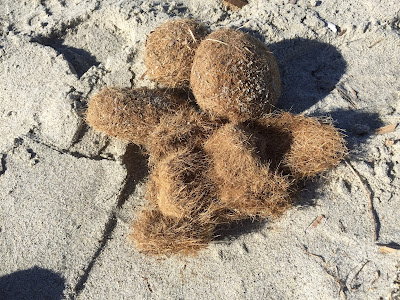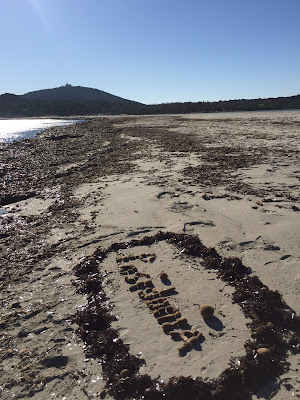

We just couldn’t let this opportunity for a Binomen Art piece pass when recently walking along a beach in Sardinia. We were on the Spiaggia di Notteri, south of Villasimius where we saw lots of brown fibrous balls. These lightweight, buoyant balls ranged in size from an inch to a couple of inches in diameter. We saw the balls on the beach near Pula as well.
We learned that the balls, nicknamed “Neptune Balls”, are from the seagrass Posidonia oceanica. The seaweed is commonly called Neptune Grass or Mediterranean tapeweed. The latter refers to the tape-like (think cassette tape) foliage. The fuzzy balls we saw on the beach are bits of this aquatic plant formed into balls through the action of waves (hence quotes around the word fruit above). In Italian, common names include “olive of the sea” (oliva del mare), “sea balls” (palle di mare), “sea meatballs” (polpette di mare). The scientific term used to refer to these spheres from the sea is egagropilo/egagropili.
The genus name Posidonia is after Poseidon, the Greek god of the seas. The species name oceanica appears to refer to the wide distribution of this plant that is now only found in the Mediterranean Sea. P. oceanica can form large underwater meadows and is being used as a bioindicator. Furthermore, there is interesting work being done to turn these beach-tribbles into useful insulation.
What we are seeing on the beach today is the result of seagrass flowering between August and November. I would guess in summer much of P. oceanica is cleared from the beach to make way for the summer invasion. According to this article, despite the number of fruits found on the beach, new seagrass “…originating from seedlings are rarely found and P. oceanica primarily propagates vegetatively by elongating the rhizomes; a whole meadow may be one single clone resulting from one ancient seedling.”
Left: Posidonia spelled with brown "sea olives". Right: P. oceanica on Spiaggia di Notteri.


Left: Spiaggia di Notteri (south of Villasimius, Sardinia) with P. oceanica, washed up on shore. Right: Assembling the binomen art piece on the beach.


Left: A Neptune ball in hand is worth two in the bush? Right: Debris from Mediterranean seagrass. The debris can help reduce the erosion of the beach.


Left: Posidonia oceanica and Capo Carbonara in the background. Right: Walkway over Stagno di Notteri.


No comments:
Post a Comment
All comments are moderated. If your comment doesn't appear right away, it was likely accepted. Check back in a day if you asked a question.